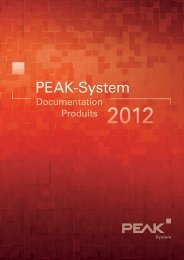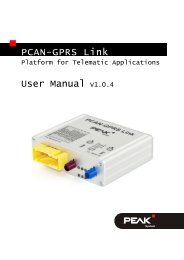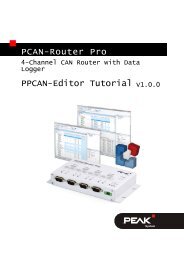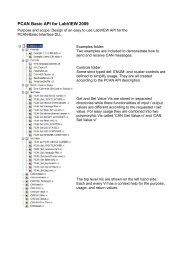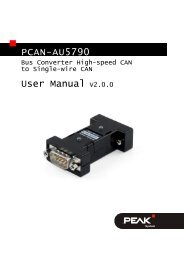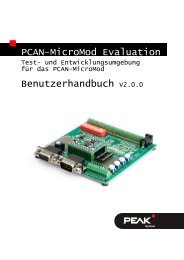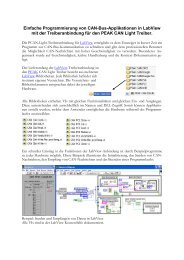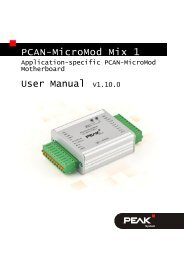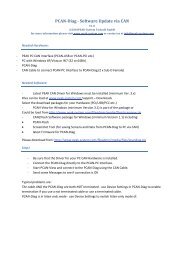1 PLIN-API Documentation - PEAK-System
1 PLIN-API Documentation - PEAK-System
1 PLIN-API Documentation - PEAK-System
Create successful ePaper yourself
Turn your PDF publications into a flip-book with our unique Google optimized e-Paper software.
2.1 <strong>PLIN</strong> Basics <strong>PLIN</strong> <strong>API</strong> <strong>Documentation</strong><br />
2 Introduction<br />
Welcome to the documentation to <strong>PLIN</strong>-<strong>API</strong>.<br />
<strong>PLIN</strong> stands for <strong>PEAK</strong> LIN Applications and it is a system for the development and use of LIN busses. It is a helpful and<br />
extensive product, directed to developers and end-users. The <strong>PLIN</strong>-<strong>API</strong> is the Programming Interface to the <strong>PLIN</strong> system<br />
which allow the real-time connection of Windows applications to the LIN busses physically connected to the PC.<br />
In this Chapter<br />
Topics Description<br />
<strong>PLIN</strong> Basics ( see page 2) This section contains an introduction to <strong>PLIN</strong>.<br />
<strong>PLIN</strong>-Client and <strong>API</strong> Basics ( see<br />
page 3)<br />
Information and process flow with a <strong>PLIN</strong> client.<br />
License Regulations ( see page 3) License regulations to this software.<br />
Contact information ( see page 4) Contact information - <strong>PEAK</strong>-<strong>System</strong> Technik GmbH.<br />
2.1 <strong>PLIN</strong> Basics<br />
The communication between the PC and an external LIN hardware through a LIN bus is done using a Windows Services<br />
called "<strong>PLIN</strong> Manager" (PLinMng.exe). It forms the basis for the interaction between the LIN software and the LIN-PC<br />
hardware. The service manages all resources and data flowing between software and hardware.<br />
The interface to the user, like in the PCAN system , are so-called <strong>PLIN</strong> Clients. With their help, the LIN bus will accessed<br />
and its internal resources managed. The <strong>PLIN</strong> system allows the connection of multiple clients to a hardware.<br />
Unlike the PCAN system, the <strong>PLIN</strong> system does not support the use of nets. A client connects directly with a hardware.<br />
Within the PCAN system, the nets are a kind of extension of the CAN bus in the PC. Since a part of the protocol stack of LIN<br />
must be processed in the hardware (in real-time), for a LIN communication is always a hardware needed. Furthermore, the<br />
development of a purely virtual LIN bus, using simulation within a PC, is not possible. If there are clients connected to a<br />
hardware (eg. PCAN-USB Pro), the communication will be interrupted if that hardware is plugged off.<br />
The following rules are used to dealing with <strong>PLIN</strong> clients and hardware:<br />
• A <strong>PLIN</strong> client can be connected to several hardware.<br />
• A hardware supplies several <strong>PLIN</strong> clients.<br />
• When a client sends, another client will gets the message/response only after the message has physically appeared on<br />
the bus.<br />
• LIN frames can be received from all connected clients, when those frames passed the client acceptance filter.<br />
• Each client has a receive queue, in which messages are waiting to be processed.<br />
• A physical LIN bus corresponds to a hardware. If an adapter contains multiple LIN bus connectors (eg. PCAN-USB pro<br />
with 2x-LIN and 2x-CAN), for each LIN-Bus will be a hardware (hardware handle) available.<br />
See Also<br />
Getting Started ( see page 5)<br />
2<br />
2



![English - Low Quality [7.2 MB] - PEAK-System](https://img.yumpu.com/5931738/1/184x260/english-low-quality-72-mb-peak-system.jpg?quality=85)
